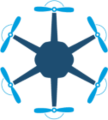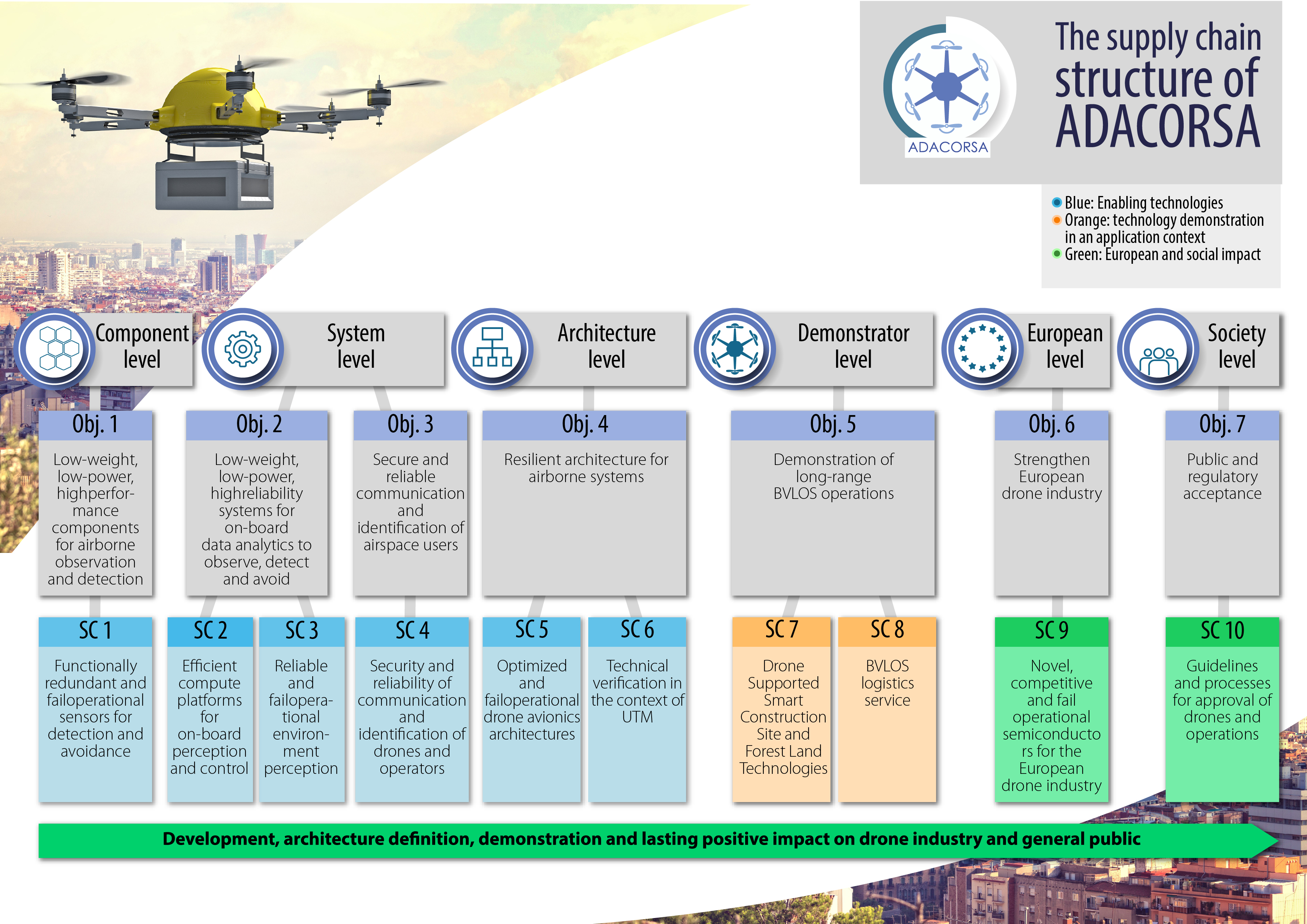A supply chain is a combination of partners with activities fitting together within a specific topic leading to a combined result such as a demonstrator for the technologies developed. Each supply chain addresses a specific ADACORSA objective. This ensures a clear understanding of responsibilities for project results and the achievement of project objectives and supports the effective and efficient collaboration between the partners in a focused manner.
SC 1: Functionally redundant and fail-operational sensors for detection and avoidance
The partners in the supply chain are ideally lined up for the development of functionally safe sensors. Infineon (Infineon and Infineon Austria) develop the semiconductors for the radar, LiDAR and 3D imaging sensors, with IUNET designing antenna arrays, Ruhr University Bochum and Fraunhofer FHR designing the PCBs and radar sensors, University of Klagenfurt providing efficient signal processing and Infineon Italia the functionally safe sensor power supplies while TU Graz works on the overall functional safety of all sensors and Bauhaus Luftfahrt links the sensor requirements to the higher-level supply chains.
SC 2: Efficient compute platforms for onboard perception and control
SC2 has a mix of partners with complementary competence in hardware and low-level software, algorithmics as well as end use-cases. KATAM brings domain knowledge of their forestry use case but also significant algorithmics experience. This is supplemented by Lund University providing additional expertise in 3D mapping. EEricsson, Infineon and Innatera focus on hardware and low-level aspects. Finally, CEA focus on the important aspect of cryptographically ensuring end-to-end integrity via Blockchains.
SC 3: Reliable and fail-operational environment perception
New approaches for fail-operational environment perception and ego-motion estimation will be developed by academic partners (TU Delft, Tampere University, University of Parma) in collaboration with the semiconductor industry (Nokia, AnyWi, Infineon Austria) and research centres (Virtual Vehicle) to be demonstrated by esc Aerospace and Avular together with automotive end-user (Ford Otosan). Besides the development of environment perception algorithms supply chain 3, will focus on the design of DAA systems (NLR) based on localization (NLR, TU Delft), transponder (Celestia, NLR) and wireless information sharing technologies (AnyWi). To further support the vision of safe and reliable environment perception algorithms virtual verification approaches (Virtual Vehicle, Tampere University, Nokia, Almende) will be applied to validate the new designed algorithms and approaches before the integration into the demonstrator drones.
SC 4: Security and reliability of communication and identification of drones and operators
Innovative technologies for secure identification of and secure cellular communication with drones will be developed by Giesecke+Devrient, Infineon, and Infineon Austria. New technologies for secure and reliable communication will be developed by NXP as an 802.11p-compliant module with integrated secure elements for the 5.8GHz band in close collaboration with Technolution for security, AnyWi for robust communication, Avular for specification and testing and CISC for a gateway reference architecture. This effort is supported by industrial and academic research provided by OTH Amberg-Weiden and ISEP on multipath communication, Bauhaus Luftfahrt on specifications, University of Parma for long-range protocols, IUNET for an electronically reconfigurable antenna system, as well as CEA and OTH Amberg-Weiden on distributed authentication and trust management systems. Innovative technologies for mobile networking via fast-deployable flying 4/5G base stations will be developed and demonstrated by Turkcell supported by TÜBİTAK for applied research.
SC 5: Optimized and fail-operational drone avionics architectures
Infineon Austria and Infineon will design and develop a highly reliable drone platform implementing a Distributed Integrated Modular Avionics (DIMA) concept. Airholding and ISEP will design and implement the P2P drone internal communication architecture and will integrate it into the DIMA concept. The fail-operational architecture will be further supported by the Deterministic Ethernet backbone network, Infineon’s next generation AURIX microcontroller integrated with PikeOS, a Real-Time OS by Sysgo (TTTECH, Infineon Austria and SYSGO) and distributed embedded flight platform including support for PX4 (NXP and Technolution). Innovative technologies for fail-operational drone avionics systems, including a network synchronization mechanisms for low latency data communication, end system driver, will be developed by TTTECH. Infineon Italia will develop safe power supply units. esc Aerospace will design and develop an innovative PNT solution, with the possibility to switch over to a backup system in case of the main system malfunction. ROBONIK will design the autonomous take-off and landing system. ANASAYFA – TUSAS will design and develop a cargo delivery drone with its control, perception and communication subsystems.
SC 6: Technical verification in the context of UTM
SC6 develops environments for the crucial service of verification of selected elements of the ADACORSA technology stack in the context of UTM, hence representing the aspect of organised interaction between drones and ground and between drones and other aircraft in potentially dense airspace of the future. The supply chain is led by Frequentis, who also develop the flight information management system. Blockchain technology developed by CEA, industrial research partners, ensures integrity and traceability of messages from drone to ground-based UTM systems, and a UTM traffic simulation environment is developed by Almende and Bauhaus Luftfahrt to provide the verification capabilities in a simulation environment. NLR provides a testbed for DAA systems, and an on-board layer to monitor onboard safety issues in collaboration with ground-based systems and other vehicles are developed by UniBW, in collaboration with Almende and Syrphus to support the use of this novel technology for regulatory compliance.
SC 7: Drone Supported Smart Construction Site and Forestry Technologies
SC7 aims to provide drone-based support to people working in "the great outdoors" on forestry and construction site applications. To that end, the SC lead, Ford Otosan, has collected a strong group of partners to provide the application development - KATAM, the drones from ANASAYFA - TUSAS, certified aircraft, and Avular, SMART and ROBONIK and supporting technologies. Among the supporting technologies are also found systems for fast deployment of mobile networks - Turkcell to support drone-based sensing for advanced applications of collaborative construction equipment, incorporating path planning algorithms from TÜBİTAK. Furthermore, SC7 will involve an onboard edge/gateway module platform (by CrossControl), as an enabler for AI, situational awareness and connectivity, enabling the autonomous collaboration of vehicles.
SC 8: BVLOS logistics service
SC8 provides support for drone-related logistic services and automated operations in BVLOS conditions. The supply chain leader, Airholding, will coordinate the work between all partners and will lead the integration tasks. AnyWi will provide a system for the communication hand-over between BVLOS ground control stations. NLR will deliver components for the Detect And Avoid system and will integrate this system into a NLR drone. esc Aerospace will deliver the system for precise positioning and will provide a drone platform for the demonstration events. ISEP, together with Airholding and esc Aerospace, will deliver modules for secure and resilient communication between ground and the onboard computer.

Acknowledgement
ADACORSA has received funding from the ECSEL Joint Undertaking (JU) under grant agreement No 876019.
The JU receives support from the European Union’s Horizon 2020 research and innovation programme and Germany, Netherlands, Austria, France, Sweden, Cyprus, Greece, Lithuania, Portugal, Italy, Finland, Turkey.
The JU receives support from the European Union’s Horizon 2020 research and innovation programme and Germany, Netherlands, Austria, France, Sweden, Cyprus, Greece, Lithuania, Portugal, Italy, Finland, Turkey.
© 2024 ADACORSA
| Imprint | Privacy Policy | Contact Us |


